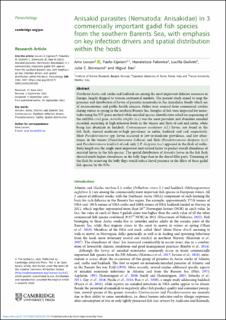| dc.contributor.author | Levsen, Arne | |
| dc.contributor.author | Cipriani, Paolo | |
| dc.contributor.author | Palomba, Marialetizia | |
| dc.contributor.author | Giulietti, Lucilla | |
| dc.contributor.author | Storesund, Julia Endresen | |
| dc.contributor.author | Bao, Miguel | |
| dc.date.accessioned | 2023-01-12T11:53:15Z | |
| dc.date.available | 2023-01-12T11:53:15Z | |
| dc.date.created | 2022-10-15T13:34:24Z | |
| dc.date.issued | 2022 | |
| dc.identifier.citation | Parasitology. 2022, 149 (SI: 14), 1942-1957. | en_US |
| dc.identifier.issn | 0031-1820 | |
| dc.identifier.uri | https://hdl.handle.net/11250/3043009 | |
| dc.description.abstract | Northeast Arctic cod, saithe and haddock are among the most important fisheries resources in Europe, largely shipped to various continental markets. The present study aimed to map the presence and distribution of larvae of parasitic nematodes in the Anisakidae family which are of socioeconomic and public health concern. Fishes were sourced from commercial catches during winter or spring in the southern Barents Sea. Samples of fish were inspected for nematodes using the UV-press method while anisakid species identification relied on sequencing of the mtDNA cox2 gene. Anisakis simplex (s.s.) was the most prevalent and abundant anisakid recorded, occurring at high infection levels in the viscera and flesh of cod and saithe, while being less abundant in haddock. Contracaecum osculatum (s.l.) larvae, not found in the fish flesh, showed moderate-to-high prevalence in saithe, haddock and cod, respectively. Most Pseudoterranova spp. larvae occurred at low-to-moderate prevalence, and low abundance, in the viscera (Pseudoterranova bulbosa) and flesh (Pseudoterranova decipiens (s.s.) and Pseudoterranova krabbei) of cod, only 2 P. decipiens (s.s.) appeared in the flesh of saithe. Body length was the single most important host-related factor to predict overall abundance of anisakid larvae in the fish species. The spatial distribution of Anisakis larvae in the fish flesh showed much higher abundances in the belly flaps than in the dorsal fillet parts. Trimming of the flesh by removing the belly flaps would reduce larval presence in the fillets of these gadid fish species by 86–91%. | en_US |
| dc.language.iso | eng | en_US |
| dc.title | Anisakid parasites (Nematoda: Anisakidae) in three commercially important gadid fish species from the southern Barents Sea, with emphasis on key infection drivers and spatial distribution within the hosts | en_US |
| dc.title.alternative | Anisakid parasites (Nematoda: Anisakidae) in three commercially important gadid fish species from the southern Barents Sea, with emphasis on key infection drivers and spatial distribution within the hosts | en_US |
| dc.type | Peer reviewed | en_US |
| dc.type | Journal article | en_US |
| dc.description.version | publishedVersion | en_US |
| dc.source.pagenumber | 1942-1957 | en_US |
| dc.source.volume | 149 | en_US |
| dc.source.journal | Parasitology | en_US |
| dc.source.issue | SI: 14 | en_US |
| dc.identifier.doi | 10.1017/S0031182022001305 | |
| dc.identifier.cristin | 2061632 | |
| dc.relation.project | Fiskeri- og havbruksnæringens forskningsfinansiering: 901628 | en_US |
| dc.relation.project | Fiskeri- og havbruksnæringens forskningsfinansiering: 901543 | en_US |
| cristin.ispublished | true | |
| cristin.fulltext | original | |
| cristin.qualitycode | 1 | |
